When traveling, I take a varying number of books with me depending on the length of the trip. One important criterion for traveling is if the book is damaged or lost, I can easily replace it or don’t care. I like the old fashioned mass market paperback due to space considerations over the trade paperback.
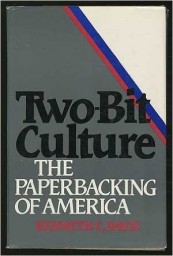 For the past 25 or so years, publishers have been using the trade paperback format for many “classic” works. At one time, you could pick up Dashiell Hammett, H. P. Lovecraft, Jim Thompson, Cornell Woolrich, or Raymond Chandler in the classic mass-market paperback format. The mass-market paperback has had some variations over the years but is roughly 4.4 x 6.8 inches (10.5 x 17.5 cm). Two-Bit Culture: The Paperbacking of America by Kenneth C. Davis is a history of the mass-market paperback book. The modern paperback had its start in 1939 with Robert de Graff’s Pocket Books. At this time, there were around 500 bookstores in the U.S. Most were concentrated in the nation’s twelve largest cities. Two thirds of American counties had no bookstores. The advent of the paperback opened up sales in drug stores, magazine stands, grocery stores, train stations, etc. There had been a few attempts at paperbacks before but de Graff hit on the formula of popular titles, large printings to bring the cost per unit down, and lower royalties than previously known to make the mass-market paperback a profitable venture.
For the past 25 or so years, publishers have been using the trade paperback format for many “classic” works. At one time, you could pick up Dashiell Hammett, H. P. Lovecraft, Jim Thompson, Cornell Woolrich, or Raymond Chandler in the classic mass-market paperback format. The mass-market paperback has had some variations over the years but is roughly 4.4 x 6.8 inches (10.5 x 17.5 cm). Two-Bit Culture: The Paperbacking of America by Kenneth C. Davis is a history of the mass-market paperback book. The modern paperback had its start in 1939 with Robert de Graff’s Pocket Books. At this time, there were around 500 bookstores in the U.S. Most were concentrated in the nation’s twelve largest cities. Two thirds of American counties had no bookstores. The advent of the paperback opened up sales in drug stores, magazine stands, grocery stores, train stations, etc. There had been a few attempts at paperbacks before but de Graff hit on the formula of popular titles, large printings to bring the cost per unit down, and lower royalties than previously known to make the mass-market paperback a profitable venture.
During WWII, there were the armed services editions of paperbacks distributed to the military. The result was probably the best read army in history up to that time. The armed services paperbacks included Sleep No More, a horror anthology edited by August Derleth that included Robert E. Howard’s “The Black Stone.” Sleep No More was Clark Ashton Smith, Robert Bloch, August Derleth, Robert E. Howard among others’ first paperback appearance.
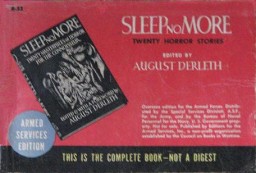
The mass-market paperback had a wonderfully egalitarian approach to publishing. Lee Server describes the approach in Over My Dead Body (Chronicle Books, 1994):
“They displayed no distinction between marginal mystery writers and titans of literature. Emile Zola or Sax Rohmer, D. H. Lawrence or Brett Halliday, everybody got the same frenzied blurbs and risqué illustrations, causing academics to tear their hair out—especially when the classic works were abridged by 50 percent and given catchy new, usually salacious, titles.”
The Ace science fiction double, Conan the Conqueror with Leigh Brackett’s Sword of Rhiannon was not a success though that was probably due more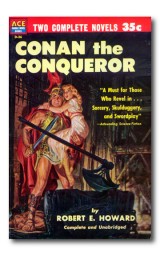 to growing pains at Ace than content. There is a story to be unearthed regarding distribution of that venerable title and the impact that may have had on sales.
to growing pains at Ace than content. There is a story to be unearthed regarding distribution of that venerable title and the impact that may have had on sales.
It was not until 1966 that Lancer made a success of bringing Robert E. Howard to the general populace. Lancer was a bottom tier publisher rumored to have organized crime connections with a capable editor in Larry Shaw and probably the best art department in paperback publishing. The combination of strong content, iconic covers provided by Frank Frazetta, and distribution to many drug store racks created a success story. Let’s not forget that the Lancer paperbacks were packed in a format competitively priced to compete for a teenager’s discretionary income.
The mass-market paperback proved to be a winning combination decades. The specialty publisher hardbacks such as Fantasy Press, Arkham House, and Gnome Press first put a number of classics in print for science fiction and fantasy readers but it was the mass market paperback that created new fans. The success of reprinting Edgar Rice Burroughs, J. R. R. Tolkien, and Robert E. Howard led to a boom in fantasy paperbacks. As late as 1983, you could walk into a B. Dalton Bookseller or Waldenbooks and find most of the Edgar Rice Burroughs catalogue, C. L. Moore’s Jirel of Joiry, Michael Moorcock’s Elric series, Karl Edward Wagner’s Kane books, Fafhrd & the Gray Mouser all present in paperback. If you were lucky, you might some of the Ace editions of Pigeons From Hell, Sowers of the Thunder, or The Howard Collector. A neophyte reader could have the cornerstones of modern fantasy available with regular trips to the local bookstore.
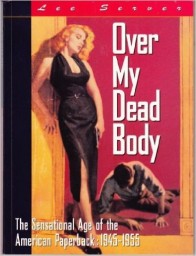 There was a shift in fantasy publishing in 1985 and sword and sorcery was out while Dennis McKiernan and the like were in. That era was wonderfully satirized in Karl Edward Wagner’s “Neither Brute nor Human” especially with an incident in which the new generation of women editors who had taken over denounced Damon Harrington’s Krystal Firewind series as sexist trash.
There was a shift in fantasy publishing in 1985 and sword and sorcery was out while Dennis McKiernan and the like were in. That era was wonderfully satirized in Karl Edward Wagner’s “Neither Brute nor Human” especially with an incident in which the new generation of women editors who had taken over denounced Damon Harrington’s Krystal Firewind series as sexist trash.
In time, a number of classic science fiction and fantasy book and authors went out of print. Del Rey books, an imprint of Ballantine, has tried a different tact by publishing Robert E. Howard, H. P. Lovecraft, and Michael Moorcock in oversize or trade paperback form.
The trade paperback has its origins in the middle 1950s. Penguin Books, Dover, Anchor Books (an imprint of Doubleday), and Vintage (an imprint of Alfred A. Knopf) all came out with paperback books that were higher priced and sold directly to bookstore trade instead of through magazine wholesalers. There was also generally a 40% discount instead of the customary 20% discount of mass-market paperbacks. The intent was to reach a smaller more specialized audience- academic, literary, and “highbrow.” Universities and colleges were important markets in the early days. A term of derision at the time for these books was “egghead” paperback.” Beacon Books and Meridian Books next brought out a large sized format paperback, which became known as a “quality paperback.” That is the direct ancestor of our Del Rey and Gollancz editions.
Originally, science fiction was different from most other genre fiction. Titles would sell small but steady numbers for years. Ballantine Books kept Isaac Asimov and Arthur C. Clarke in print for years with multiple printings. Bantam did the same with Louis Lamour. Classic titles would be guaranteed of being on the shelves of a bookstore for years. About fifteen years ago there was a change, classic titles were reissued in oversized paperback editions that also cost more. The mass-market paperback became the domain of fat fantasy novels, often part of a series, typified by Robert Jordan’s Wheel of Time series. Publishers want their mass-market paperbacks to be the equivalent of Frampton Comes Alive. The mid-list no longer exists. The distribution system that once existed is also gone. Barnes & Noble dictated to publishers on what to produce.
There has also been inflation to the point that a paperback is no longer an impulse item. Twenty-five years ago, you could stop and pick up a few paperbacks after going to the record store and getting the newest album that you had to have and think nothing of it. Nowadays, you have to justify 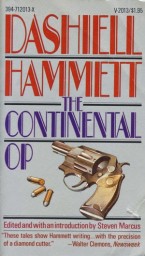 spending $7.99 with Sturgeon’s Law always in the back of your mind. James Reasoner, an author a good number of paperbacks himself, once told me that the price for paperbacks should be equivalent to one hour at the minimum wage. Going by that formula, mass-market paperbacks should be $5.15. Are these higher prices translating into better royalties for the writers? Economics are driving the conversion to oversized paperbacks. Publishers can produce smaller numbers of oversized trade paperbacks and no lose money. Bookstores can keep the classic reprints on the shelves for years instead of sending the covers for credit for the next batch of books.
spending $7.99 with Sturgeon’s Law always in the back of your mind. James Reasoner, an author a good number of paperbacks himself, once told me that the price for paperbacks should be equivalent to one hour at the minimum wage. Going by that formula, mass-market paperbacks should be $5.15. Are these higher prices translating into better royalties for the writers? Economics are driving the conversion to oversized paperbacks. Publishers can produce smaller numbers of oversized trade paperbacks and no lose money. Bookstores can keep the classic reprints on the shelves for years instead of sending the covers for credit for the next batch of books.
Now we have some classics available in oversized paperback for $15.95. Granted there are some benefits to the format in having interior art and miscellaneous items included. You have to be careful with these books though. You can’t travel with them easily. The Del Rey books are less cumbersome than the Gollancz books but you still are going to dog-ear and crease the edges of the cover unless taking the greatest of care even when putting the book into a mylar bag. I am going to wax nostalgic but my mass-market paperbacks. You can put them into the inside pocket of your jacket or in your book bag and travel. There is also something pleasing about the amount of fiction in a mass-market paperback. The oversized trade paperback can have an intimidating amount of fiction in it making it seemingly less digestible. Come on and admit it- how many of you have read through completely your recent Del Rey or Gollancz editions? Remember getting that first Heinlein, Asimov, or Robert E. Howard paperback and devouring the contents in a couple of nights? 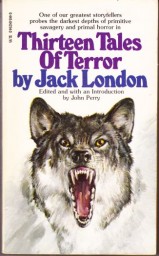 Wolfshead (Bantam edition) was not my first Robert E. Howard paperback but reading it was an almost perfect experience. I had exhausted Conan and also read five other Howard paperbacks at that time and found it still on the shelves three years after publication at a bookstore in Pittsburgh. It was a grab bag collection of Robert E. Howard horror and prehistoric fantasy and I enjoyed every page of it. An eclectic collection like that would never be published today. I have a huge leather bound Jack London omnibus that runs 1143 pages that I found at an outlet mall 16 years ago. I hardly ever open it up. On the other hand, I have dipped into a bizarre little collection called Thirteen Tales of Terror (Popular Library, 1978). This book was packaged to appeal to the readers of Peter Benchley who was very popular at the time. I am glad that I bought Dashiell Hammett’s The Big Knockover and The Continental Op back when they were mass-market paperbacks. I am more likely to crack open the Ballantine editions of H. P. Lovecraft instead of the Penguin trade paperbacks.
Wolfshead (Bantam edition) was not my first Robert E. Howard paperback but reading it was an almost perfect experience. I had exhausted Conan and also read five other Howard paperbacks at that time and found it still on the shelves three years after publication at a bookstore in Pittsburgh. It was a grab bag collection of Robert E. Howard horror and prehistoric fantasy and I enjoyed every page of it. An eclectic collection like that would never be published today. I have a huge leather bound Jack London omnibus that runs 1143 pages that I found at an outlet mall 16 years ago. I hardly ever open it up. On the other hand, I have dipped into a bizarre little collection called Thirteen Tales of Terror (Popular Library, 1978). This book was packaged to appeal to the readers of Peter Benchley who was very popular at the time. I am glad that I bought Dashiell Hammett’s The Big Knockover and The Continental Op back when they were mass-market paperbacks. I am more likely to crack open the Ballantine editions of H. P. Lovecraft instead of the Penguin trade paperbacks.
There is irony in having genre fiction presented in a book format originally designed for a market that would have considered this as trash. The mass-market paperback has been good to many writers. I hate to see that era gone. While traveling on a plane, I would like to have Howard available in mass-market paperback. I know I won’t be taking an oversized trade paperback again. If given a choice, I would rather buy a mass market hardback the same size as the oversize trade paperback. A hardback holds up better. The oversized trade paperback combines the worse aspects of both mass market paperback and hardback books- the format lacks the durability of the hardback, costs more than a mass market paperback, and isn’t as portable. The best scenario would be to have your classics such as Lovecraft, Howard, Leiber in the same position as Tolkien- available in all formats. Then I could have the hardbacks for reading at home and mass-market paperback for traveling. Just leave the oversized trade paperback out of the equation.
I share both your disdain for the trade pb format and your nostalgia for the mass market size. Here in the UK it endured into the 90s but now, like Bal-Sagoth, is likewise a thing of “dreams and ghosts and smoke”.
Regrettably e-readers have now taken the whole idea of transportability and convenience – with regards to real books – out of the equation. They have also allowed publishers to further slash costs with regards to packaging and design. As if modern books weren’t dully generic looking already. Can anyone name a new book published in the last twenty years that can boast a cover design to compete with a Pennington, Foss or Frazetta painting?
Thankfully there remain nine decades worth of old and convenient and well designed pbs to discover and explore, and save one the trouble of buying badly designed new ones.
-
“Can anyone name a new book published in the last twenty years that can boast a cover design to compete with a Pennington, Foss or Frazetta painting?”
This is totally self-serving, but since you asked…
http://dmrbooks.storenvy.com/products/11974566-swords-of-steelAnd it’s mass-market size, too!
Coincidentally, the author of the title story, Byron Roberts, was the singer for a band called Bal-Sagoth.
-
That cover is the business. My buddy Dutch told me to get that book. I think he knows you. If you don’t who I am talking about then forget I mentioned it! Maybe he knows a contributor.
-
That is a striking cover. No question about it.
But I should have been more catagoric. I meant any book issued by a big time publishing house.
The small press and the smaller imprints can always be relied upon to be more inventive.
-
Wonderful article.
My copy of Wolfshead is still serviceable. I used to carry that and others in my back pocket. That was high school. They were so easy to read, so easy to handle. I have some paperback Howard reprints from Baen from later years and I still have my Lancer Conans but they are a bit desiccated and would not hold up in my jeans. I have some of the Del Rey Conans, the bigger ones, but I have them mainly for reference. They don’t have the grab and gobility of the old paperbacks, as you stated.
I have not seen a book published since I don’t know when that had the eye appeal of a Frazetta or Jones. It sounds trite but for me the cover matters. Frazetta set the table for me. Howard served up the goods, no question about that. I would have enjoyed it anyway. But Frazetta set a tone. For my little self published collection I used a watercolor of my own. Its ok for what it is. But I will take a real painting over some ham fisted photoshop thing with a stock model over some background. There is good cheesy and bad cheesy. I’ll take a Ken Kelly over some photo of a model in chain mail any day of the week.
I love those old paper-backs with the lavishly illustrated covers. Great way to pass an afternoon or a long trip.
The mass-market paperback is the perfect size.
I once bought a trade size to replace the paperback I had started reading. I’d thought the trade size edition would be easier to read.
I get home to find that the print of the trade size edition was actually smaller than that of the paperback.
Good thing it was from a used bookstore.
This is a great article. Lots of history to make any reader angry.
Lord, I hated the advent of these pocket picking things. One of the many things that propelled me into the e-book camp was the extinction of cheap, mass market paperbacks that could be shoved into a pocket and read anywhere at anytime. And with the death of the midlist titles, the loss of writers like Simak, Piper, Dickson, etc.
Don’t even get me started on the horror that is contemporary cover art. Photo-realistic, unshaven hipster heroes, lots of smoke, etc. Nothing that actually makes me want to buy the book.